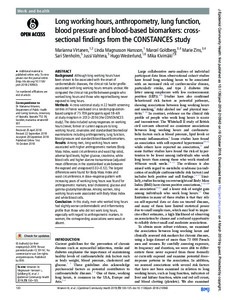Long working hours, anthropometry, lung function, blood pressure and blood-based biomarkers: Cross-sectional findings from the CONSTANCES study
Marianna Virtanen; Linda Magnusson Hansson; Marcel Goldberg; Marie Zins; Sari Stenholm; Jussi Vahtera; Hugo Westerlund; Mika Kivimäki
https://urn.fi/URN:NBN:fi-fe2021042826016
Tiivistelmä
Background Although long working hours have been shown to be associated with the onset of cardiometabolic diseases, the clinical risk factor profile associated with long working hours remains unclear. We compared the clinical risk profile between people who worked long hours and those who reported being never exposed to long hours.
Methods A cross-sectional study in 22 health screening centres in France was based on a random population-based sample of 75 709 participants aged 18–69 at study inception in 2012–2016 (the CONSTANCES study). The data included survey responses on working hours (never, former or current exposure to long working hours), covariates and standardised biomedical examinations including anthropometry, lung function, blood pressure and standard blood-based biomarkers.
Results Among men, long working hours were associated with higher anthropometric markers (Body Mass Index, waist circumference and waist:hip ratio), adverse lipid levels, higher glucose, creatinine, white blood cells and higher alanine transaminase (adjusted mean differences in the standardised scale between the exposed and unexposed 0.02–0.12). The largest differences were found for Body Mass Index and waist circumference. A dose–response pattern with increasing years of working long hours was found for anthropometric markers, total cholesterol, glucose and gamma-glutamyltransferase. Among women, long working hours were associated with Body Mass Index and white blood cells.
Conclusion In this study, men who worked long hours had slightly worse cardiometabolic and inflammatory profile than those who did not work long hours, especially with regard to anthropometric markers. In women, the corresponding associations were weak or absent.
Kokoelmat
- Rinnakkaistallenteet [27094]
